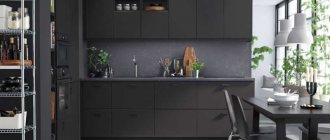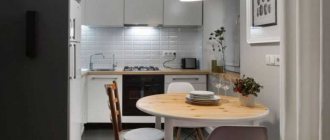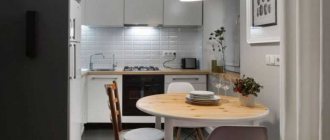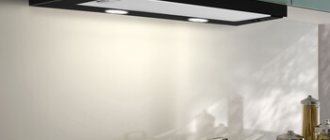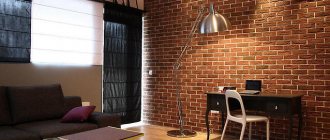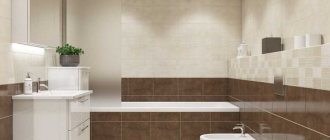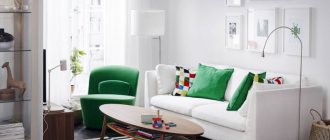Glossy Glazed Tile
Glazed gloss tiles are most often used for backsplash and wall designs as they are much less thick and durable than regular tiles or porcelain tiles. Sometimes glossy tiles have an ombre effect: this means that the tiles are slightly different in color (in undertones) and create the effect of being hand-fired in a rustic kiln (as in Moroccan zellige tiles, for example).
In Russia, a fashionable version of locally produced glazed tiles is called “boar”, since previously each tile had two through holes, which resembled a pig’s snout. Most often, such tiles have the shape of a brick, which, like the brick itself, is laid horizontally. True, there are also more interesting styling options: French herringbone, vertical layout, unusual geometric patterns with cutting on the spot.
Glazed kitchen tiles are most often accent tiles. For example, fashionable emerald, wine red, turquoise, bright yellow, pink colors. The accent tiles are illuminated with an LED strip at the bottom of the upper cabinets and look even more beautiful! Italian kitchens look great with glazed backsplash tiles!
Price of glazed kitchen tiles: 3,000–6,000 RUR/m², made in Great Britain.
English encaustic tiles
In Cuba it is called losa hidroulica, in Miami - Cuban tile, in Italy - pavimenti in graniglia, in France and Belgium - carrelages du cimen, and in the UK, where its production was first put into production in Europe - encaustic tile. A special feature of the tile is the creation of a pattern from cement-clay mortar in a specific shape. A clay-cement mortar is poured into the mold, pressed and hardened. There is no firing here, so encaustic tiles create an almost concrete floor; they are cold and heavy, unlike ceramic tiles.
Encaustic imitations are made on the basis of standard ceramics or porcelain stoneware. Thus, encaustic style tiles for the kitchen can be either concrete or standard. And the prices are completely different. At the same time, there are multi-colored tiles, and in a black and white kitchen you can find gray and white or black, gray and white versions.
The cost of original encaustic tiles: 10,000–15,000 RUR/m² made in the UK or France.
The cost of tiles or porcelain tiles with an encaustic pattern: 4,000–6,000 RUR/m², produced in Spain and Russia.
Types of floor tiles
Ceramic tiles are mostly installed in the kitchen. It is divided into tiles, porcelain tiles, marble and granite tiles.
Ceramics are chosen for their increased wear resistance, which is due to the hardness of the material. Another important plus is hygiene. It is easy to clean and does not accumulate microorganisms such as mold and mildew on the surface.
Calculate the exact cost of repairs using an online calculator
and receive a free detailed estimate for repairs
Calculate
This tile contains clay, therefore, the material is fireproof and not harmful to health. Another advantage of ceramic tiles for kitchen floors is that they do not conduct electricity. An important advantage is the availability of a wide range of colors: you can choose ceramic tiles with any pattern that matches the style of the overall kitchen interior.
The disadvantages include high thermal conductivity, which is why the surface of the tile is always cold. The problem is solved by installing a heated floor system. Ceramic tiles are fragile and can chip easily, so you need to be extremely careful when installing them.
Porcelain tiles are also highly durable. Of the minuses, it should be noted that the surface of porcelain stoneware is very slippery, you should be especially careful when water gets on it.
Both granite and marble tiles are characterized by great resistance to high and low temperatures. Nevertheless, the strength of granite due to its density is much higher. The disadvantage of granite tiles is the complexity of laying and installation.
The advantage of marble tiles is that they are more susceptible to mechanical action, including polishing, than granite ones. However, the durability of marble tiles is almost five times less than the durability of granite tiles, although such tiles look very expensive.
Photo: idei-dekoru.com
Wood-look tiles are considered one of the most expensive types of tiles. Unlike ordinary wooden material, such tiles can withstand even high temperatures, have a non-rough surface, do not rot, and have a long service life.
Photo: img.benimmulku.com
Stone-look tiles are usually polished marble. Marble and granite tiles are characterized by great strength and resistance to high and low temperatures. However, they are not easy to lay: you will need to first lay out the stone dry to check whether the existing tiles are enough. This will also help determine how best to process the corners and join the stone tiles together.
Portuguese azulejo tiles
Azulejos are a form of Portuguese and Spanish tin-glazed ceramic tile painting. Azulejos are found inside and outside churches, palaces, ordinary houses, schools, and these days in the interior design of restaurants, bars, even train and metro stations. They were a form of decorative art, but had a specific functional ability, such as controlling the temperature in homes.
There is a tradition of their production in the former Portuguese and Spanish colonies in North America, South America, and Indo-China. Azulejos (both painting and tile work) are an important part of Portuguese architecture. Most azulejos are simple floral patterns, assembled like patchwork, where each tile has its own color and range. One kitchen backsplash can contain from 6 to 15 different types of azulejo tiles.
Azulejo style kitchen tiles are ideal for kitchen interior design in Provence, country and Mediterranean styles (Spanish and Italian, in particular). It can also be ideal for an eclectic ethnic interior. Azulejos in a gray and white palette are often used in Scandinavian interior design.
Price of kitchen tiles with imitation azulejo: 3,000–8,000 RUR/m², made in Italy.
Unusual backsplash tiles
In small kitchens, designers advise choosing an apron that matches the color of the furniture. In such cases, tiles of unusual shape will provide the service of originality. In addition to squares and rectangles, on the kitchen wall there can be: hexagons, triangles, pentagons, scale tiles, rhombuses, round mosaics, hexagonal mosaics, arabesques and others.
Ceramic mosaic Rainbow Co, GEOMETRY collection
If the size of the kitchen allows it, or the rule has only strengthened the desire to break it, experiment with colors. Bright kitchen aprons will not go unnoticed. Red, yellow, green - everything that contrasts with the furniture and the overall design of the kitchen. Take a closer look at the black one: of all the colored aprons, this is by far the most spectacular.
Zellige Ait Manos, handmade tiles, Morocco
A convenient way to express yourself is to choose a tile with a pattern. If you want to be known as an innovator and be at the forefront of interior trends every year, love Popham Design. They are a brand of traditional cement tiles with an amazing approach to design. The already fashionable geometry in this tile is transformed according to all the rules of cool, and any choice you make will be a success. Geometry can also be found in porcelain tile manufacturers that imitate the matte surface of cement tiles in a more affordable price segment.
Cement tiles Popham Design, Morocco, ZIGZAG collection
Cement tiles Popham Design, Morocco, BACKGAMMON collection
Exotic River cement-look porcelain tiles, LOFT collection
In addition to the color and shape, the surface is also original. In the fight against the brilliant gloss of ceramic tiles, matte cement tiles are inferior in popularity, but not in originality. Another option for an unusual surface is a relief pattern.
Cement tiles Mosaic del Sur, Spain
Ceramic tiles Bestile, Spain, ZURBARAN REACTIVO collection
Even rectangular hog tiles can become unusual if you know about alternative installation methods or combine rectangles with a square.
Diffusion Ceramique tiles, France, METRO collection.
Yulia Nesterova's
Patchwork project is a proven classic among unusual solutions. In addition, patchwork has a number of advantages:
— the selection of tiles for a collage is not affected by warehouse availability, since even single samples can be purchased to create patchwork
- such a patchwork apron is not limited to one country style and is harmonious both in high-tech and Scandinavian minimalism
- you can add any of the rules above to the effectiveness of the patchwork itself, for example, choose a monochrome palette that is unusual for patchwork
Patchwork from Carocim cement tiles, France.
Project Model Bananova
Black and white geometric patchwork of Azuvi ceramic tiles, Spain, WALLS collection
Moroccan zellige tiles
Zellige style kitchen tiles are traditionally handcrafted from unrefined natural clay mined in the Fes region of Morocco. The clay is mixed with water, shaped by hand, dried naturally and fired in a kiln. Glass enamel in several translucent shades is then applied to the surface of the raw tile, called bisque, to create a pearlescent, metallic, volcanic or opaque finish. The enamel is melted and vitrified during further firing in a kiln. The final stage of zellige production involves cutting the enamel pieces into an endless collection of tiles of various shapes and sizes. Zellige is characterized by variations in tone, gloss, flatness, transparency and depth of glazing, as well as surface texture with irregularities. Each zellige tile is completely unique.
The price of tiles for a kitchen in the zellige style is 10,000–15,000 ₽/m² made in Morocco, with imitation 3,000–5,000 ₽/m² made in Spain or Russia.
Pros and cons of ceramic tiles
In the kitchen, ceramic tiles are mainly laid: they are characterized by increased wear resistance due to the hardness of the material. Another advantage is hygiene: it is easy to clean and does not accumulate fungus and mold on the surface.
This tile contains clay, therefore, the material is fireproof and not harmful to health. Another advantage of ceramic tiles for kitchen floors is that they do not conduct electricity. An important advantage is the availability of a wide range of colors: you can choose ceramic tiles with any pattern that matches the style of the overall kitchen interior.
One of the disadvantages is the high thermal conductivity, which is why the surface of the tile is always cold. Ceramic tiles are fragile and can chip easily, so you need to be extremely careful when installing them. It is also quite slippery if you spill water.
Photo: idei-dekoru.com
Italian geometric inlay or marble marquetry
Kitchen tiles with geometric inlay or marquetry are usually a combination of several types of marbled porcelain tiles in the floor design. Geometric and figurative marquetry inlays emerged from working with marble and veneer in Florence, Italy. A magical middle ground between artisanal know-how and national Italian creativity, between knowledge of materials and the ability to use their best chromatic qualities. Accurate selection, calculations, design. To this must be added vision, artistic sensitivity and an extreme passion for precise craftsmanship. The interior design of a modern kitchen in a neoclassical or classic style often contains such finishes.
The long tradition of marble and natural stone inlay, to which Italy has always given the highest expression, is now one of the main trends in marble finishing. The art of natural stone and marble marquetry originated in Italy during the Roman Empire, thanks to artistic influences from Asia Minor, which continued in subsequent centuries in the decoration of floors and walls with various types of geometric patterns in marble. The true peak of grandeur and beauty, however, was reached in the sixteenth century, when Lorenzo de' Medici gave birth to Florence in the so-called Opificio delle pietre dure.
For geometric inlays in marble or natural stone, the choice of materials is of fundamental importance, because it is through the interplay of their chromaticism and the graphics of the veins and spots that aesthetic results of the highest quality can be achieved. The combination of different types of marble, granite, quartzite, agate, labradorite, onyx can look completely special.
Brass inlay is also popular. Today, designers all over the world love kitchen tiles for a backsplash in the marquetry style, especially those with brass inlay. Kitchen tiles on the entire wall can also be made in this style.
You can buy kitchen tiles made of natural marble with geometric inlay for 15,000–35,000 RUR/m², depending on the complexity of the pattern.
